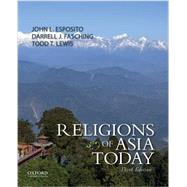Ideal for courses in Asian/Eastern religions, Religions of Asia Today, Third Edition, covers the same material contained in the authors' longer textbook, World Religions Today, Fifth Edition, while also featuring a unique chapter on Islam in Asia. Revealing the significance of religion in contemporary life, it explores Hinduism, Buddhism, South Asian religions, East Asian religions, indigenous religions, and new religions as dynamic, ongoing forces in the lives of individuals and in the collective experience of modern societies.
This unique volume accomplishes two goals: it connects today's religions to their classical beliefs and practices and focuses on how these religions have both radically changed the modern world and been changed by it. The book is enhanced by numerous pedagogical aids--text boxes, timelines, maps, illustrations, discussion questions, a comprehensive glossary of key terms, and suggestions for further reading--and more than 100 photographs. For a wealth of additional teaching and study resources, visit the book's Companion Website.
Also available to suit your course needs:
World Religions Today, Fifth Edition:
978-0-19-999959-0
Religions of the West Today, Third Edition:
978-0-19-999963-7






